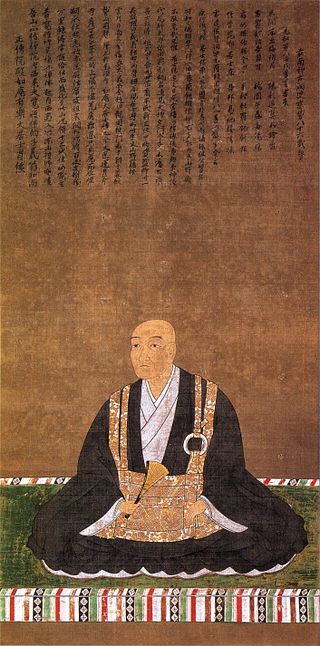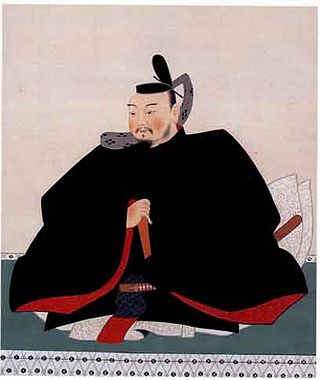
Toyotomi Hideyoshi, otherwise known as Kinoshita Tōkichirō and Hashiba Hideyoshi, was a Japanese samurai and daimyō of the late Sengoku and Azuchi-Momoyama periods and regarded as the second "Great Unifier" of Japan. Although he came from a peasant background, his immense power earned him the rank and title of Kampaku and Daijō-daijin, the highest official position and title in the nobility class. He was the first person in history to become a Kampaku who was not born a noble. He then passed the position and title of Kampaku to his nephew, Toyotomi Hidetsugu. He remained in power as Taikō (太閤), the title of retired Kampaku, until his death. It is believed, but not certain, that the reason he refused or could not obtain the title of shogun (征夷大将軍), the leader of the warrior class, was because he was of peasant origin.

Maeda Toshiie was one of the leading generals of Oda Nobunaga following the Sengoku period of the 16th century extending to the Azuchi–Momoyama period. His preferred weapon was a yari and he was known as "Yari no Mataza" (槍の又左), Matazaemon (又左衛門) being his common name. He was a member of the so-called Echizen Sanninshu along with Sassa Narimasa and Fuwa Mitsuharu. The highest rank from the court that he received is the Great Counselor Dainagon.

Oda Nagamasu was a Japanese daimyō and a brother of Oda Nobunaga who lived from the late Sengoku period through the early Edo period. Also known as Yūraku (有楽) or Urakusai (有楽斎), the Tokyo neighborhood Yūrakuchō is named for him. Nagamasu converted to Christianity in 1588 and took the baptismal name of John.

Shibata Katsuie or Gonroku (権六) was a Japanese samurai and military commander during the Sengoku period. He served Oda Nobunaga as one of his trusted generals, was severely wounded in the 1571 first siege of Nagashima, but then fought in the 1575 Battle of Nagashino and 1577 Battle of Tedorigawa.

Etchū Province was a province of Japan in the area that is today Toyama Prefecture in the Hokuriku region of Japan. Etchū bordered on Noto and Kaga Provinces to the west, Shinano and Hida Provinces to the south, Echigo Province to the east and the Sea of Japan to the north. Its abbreviated form name was Esshū (越州).

Maeda Toshinaga was a Sengoku period Japanese samurai and the second early-Edo period daimyō of Kaga Domain in the Hokuriku region of Japan, and the 3rd hereditary chieftain of the Maeda clan. He was the eldest son of Maeda Toshiie. His childhood name was "Inuchiyo" (犬千代).

Uesugi Kagekatsu was a Japanese samurai daimyō during the Sengoku and Edo periods. He was the adopted son of Uesugi Kenshin and Uesugi Kagetora’s brother in law.

Niwa Nagashige was a Japanese daimyō who served the Oda clan. Nagashige was the eldest son of Niwa Nagahide and married the 5th daughter of Oda Nobunaga. He took part in his first campaign in 1583, assisting his father in the Battle of Shizugatake against Shibata Katsuie. In 1584, the Battle of Nagakute, at the age of thirteen, Nagashige led a troop of the Niwa clan in place of his father, who was ill.

Horio Yoshiharu was a Japanese daimyō during the Azuchi–Momoyama and Edo periods. He was appointed to the position of one of san-chūrō by Toyotomi Hideyoshi along with Ikoma Chikamasa and Nakamura Kazuuji. He was the first leader of the Matsue clan and also known as Horio Mosuke.
The 1582 Siege of Uozu Castle was part of a border dispute between two daimyō of Japan's Sengoku period. The territories of Oda Nobunaga and the Uesugi clan, led by Uesugi Kagekatsu, met in Etchu Province; both were under threat from the Ikkō-ikki of Etchu, and from one another.
The Siege of Suemori was a battle during the Azuchi–Momoyama period of Japan. At the time of the Battle of Komaki and Nagakute, Sassa Narimasa sided with Tokugawa Ieyasu, while his former companion, Maeda Toshiie stood with Toyotomi Hideyoshi.

Sassa Narimasa was a Japanese samurai lord of the Sengoku through Azuchi–Momoyama periods. He entered Oda Nobunaga's service at the age of 14 and remained in his service throughout Nobunaga's rise to power. He was a member of the so-called Echizen Sanninshu along with Maeda Toshiie and Fuwa Mitsuharu. He was also known as Kura-no-suke (内蔵助).

The Niwa clan was a Japanese samurai clan of northern Honshū that claimed descent from Emperor Kanmu via Prince Yoshimine no Yasuo (785-80) and Kodama Koreyuki (d.1069).

Maeda Matsu (前田まつ), also known as Omatsu no Kata (お松の方) (1547–1617), was a Japanese noble lady and aristocrat of the 16th century. She was the wife of Maeda Toshiie, who founded the Kaga Domain. Matsu had a reputation for intelligence; she was skilled at both literary and martial arts, she fought alongside her clan. Known for her fierce determination, Matsu was vitally important to the success of the Maeda clan, being at the forefront of many political and diplomatic issues. She was eternalized for saving the Maeda clan from Tokugawa Ieyasu in Battle of Sekigahara and Siege of Osaka.

Hachiya Yoritaka was a Japanese samurai of the Sengoku period who served the Oda clan. First he served the Toki clan and Saito clan. When Oda Nobunaga started campaign on Mino Province, he became a vassal of Nobunaga as a member of "Kuro-horo-shu"

Toyama Castle is a flatland-style Japanese castle located in the city of Toyama, Toyama Prefecture, in the Hokuriku region of Japan. It is also called Azumi Castle. Built in 1543, the castle and its surrounding land is maintained by the government of Japan as a public park.

The furaribi is a fire yōkai that appears in Japanese classical yōkai pictures such as in the Gazu Hyakki Yagyō by Sekien Toriyama, the Hyakkai Zukan by Sawaki Suushi, and the Bakemonozukushi by an unknown author.

Yasuda Castle was a Sengoku period flatland-style Japanese castle located in the Fuchu neighborhood of the city of Toyama, Toyama Prefecture in the Hokuriku region of Honshu, Japan. The ruins have been protected as a National Historic Site since 1981.

Masuyama Castle was a Muromachi period yamashiro-style Japanese castle located in what is now part of the city of Tonami, Toyama Prefecture in the Hokuriku region of Honshu, Japan. The ruins have been protected by the central government as a National Historic Site since 2009. It was also known as Wada Castle

The Kanetsu Border Castle ruins is the name for a group of ruined castles and sites along the border of what is now Ishikawa Prefecture and Toyama Prefecture connected with the Sengoku period conflict between the warlords Maeda Toshiie and Sassa Narimasa. The ruins were designated a National Historic Site in 2015.



















